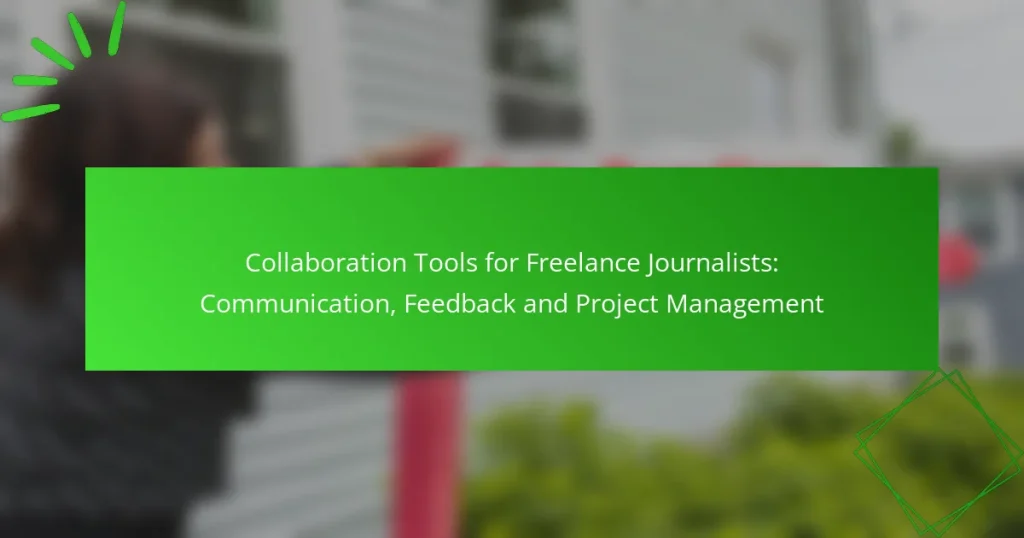Collaboration tools are essential for freelance journalists, enabling effective communication, streamlined project management, and efficient document sharing. By utilizing these platforms, journalists can enhance their workflow, ensuring alignment with editors and fellow freelancers while minimizing misunderstandings. Tools like Google Docs and Frame.io are particularly valuable for providing real-time feedback and facilitating collaborative editing, making them indispensable in today’s fast-paced media landscape.

What are the best collaboration tools for freelance journalists in the UK?
The best collaboration tools for freelance journalists in the UK include platforms that enhance communication, streamline project management, and facilitate document sharing. These tools help journalists work efficiently, especially when collaborating with editors and other freelancers across various projects.
Slack for communication
Slack is a popular messaging platform that enables real-time communication among team members. It allows users to create channels for specific projects or topics, making it easy to keep discussions organized and accessible.
Consider using Slack’s integration features to connect with other tools like Google Drive or Trello, which can enhance your workflow. Be mindful of notification settings to avoid distractions during critical writing periods.
Trello for project management
Trello is a visual project management tool that uses boards, lists, and cards to help track tasks and deadlines. Freelance journalists can create boards for different assignments, allowing them to visualize their workflow and prioritize tasks effectively.
Utilize Trello’s checklist feature to break down larger projects into manageable steps. Regularly update your boards to reflect progress and ensure that all team members are on the same page regarding deadlines and responsibilities.
Google Drive for document sharing
Google Drive is a cloud-based storage service that allows users to store and share documents easily. Freelance journalists can collaborate on articles in real-time, making it simple to provide feedback and make edits simultaneously.
Take advantage of Google Docs’ commenting feature to leave notes for collaborators. Ensure that you manage sharing permissions properly to maintain control over who can view or edit your documents.
Asana for task tracking
Asana is a task management tool that helps teams organize and track their work. Freelance journalists can use Asana to create tasks for each writing assignment, set deadlines, and assign responsibilities if working with others.
Leverage Asana’s calendar view to visualize upcoming deadlines and ensure that you stay on track. Regularly review your tasks to adjust priorities as needed and keep your projects moving forward.
Zoom for virtual meetings
Zoom is a video conferencing tool that facilitates virtual meetings, making it ideal for discussions with editors or collaborators. It offers features like screen sharing and recording, which can enhance communication and ensure everyone is aligned.
When scheduling meetings, consider time zone differences if collaborating with international teams. Keep meetings focused and concise to maximize productivity, and use the recording feature to revisit discussions later if needed.

How can freelance journalists improve communication?
Freelance journalists can enhance communication by leveraging digital tools and establishing clear protocols. Effective communication ensures that all parties are aligned, reducing misunderstandings and improving collaboration.
Utilizing instant messaging platforms
Instant messaging platforms like Slack, Microsoft Teams, or WhatsApp facilitate real-time communication, making it easier for freelance journalists to connect with editors and sources. These tools allow for quick exchanges of ideas, feedback, and updates, which can significantly speed up the reporting process.
When choosing a platform, consider factors such as user-friendliness, integration with other tools, and the ability to create channels for specific projects. For example, creating a dedicated channel for a particular story can keep all relevant discussions organized and accessible.
Setting clear communication guidelines
Establishing clear communication guidelines is essential for ensuring that all team members understand expectations. This includes defining preferred communication methods, response times, and the level of detail required in updates or feedback.
For instance, you might specify that urgent matters should be communicated via instant messaging, while less critical updates can be sent through email. Additionally, setting a standard response time of 24 hours for emails can help manage expectations and improve overall communication efficiency.

What feedback tools are effective for freelance journalists?
Effective feedback tools for freelance journalists facilitate clear communication and enhance collaboration on projects. Tools like Google Docs and Frame.io stand out for their capabilities in real-time editing and video feedback, respectively.
Google Docs for real-time collaboration
Google Docs allows freelance journalists to collaborate in real-time, making it easy to share articles and receive instant feedback. Users can comment directly on text, suggest edits, and track changes, which streamlines the revision process.
To maximize its effectiveness, set clear guidelines for feedback, such as using comments for questions and suggestions for edits. This helps maintain focus and clarity during discussions. Additionally, consider using the version history feature to revert to previous drafts if needed.
Frame.io for video feedback
Frame.io is an excellent tool for freelance journalists working with video content, as it enables precise feedback on visual media. Users can upload videos and invite collaborators to leave time-stamped comments, ensuring that feedback is specific and actionable.
When using Frame.io, encourage team members to provide feedback in a structured manner, focusing on key aspects like content, pacing, and visuals. This approach helps streamline the editing process and ensures that all feedback is addressed efficiently. Be mindful of the platform’s pricing tiers, which can vary based on storage and user limits, to choose the best plan for your needs.

How to manage projects efficiently as a freelance journalist?
Efficient project management for freelance journalists involves organizing tasks, meeting deadlines, and facilitating communication. By utilizing the right tools and strategies, you can streamline your workflow and enhance productivity.
Using Kanban boards
Kanban boards are visual tools that help freelance journalists track their tasks and projects in a clear, organized manner. Each task is represented by a card that moves through different stages, such as “To Do,” “In Progress,” and “Completed.” This method allows you to see your workload at a glance and prioritize effectively.
Popular platforms like Trello and Asana offer customizable Kanban boards. You can create lists for different projects or clients, making it easier to manage multiple assignments simultaneously. Remember to update your board regularly to reflect your current progress and avoid bottlenecks.
Implementing deadline reminders
Setting deadline reminders is crucial for freelance journalists to ensure timely submissions and maintain professionalism. Use digital calendars or project management tools to set alerts for upcoming deadlines. This practice helps you stay on track and reduces the risk of last-minute stress.
Consider using apps like Google Calendar or Todoist, which allow you to set recurring reminders and notifications. Aim to set reminders a few days in advance to give yourself ample time to review and finalize your work. Avoid relying solely on memory, as it can lead to missed deadlines and lost opportunities.

What criteria should freelance journalists consider when choosing collaboration tools?
Freelance journalists should prioritize ease of use, integration capabilities, and cost-effectiveness when selecting collaboration tools. These factors directly impact productivity and the quality of communication and feedback throughout the project lifecycle.
Ease of use
Collaboration tools should be intuitive and user-friendly to minimize the learning curve. A straightforward interface allows journalists to focus on their work rather than struggling with software. Look for tools that offer tutorials or customer support to assist with onboarding.
Consider tools that provide mobile access, enabling journalists to collaborate on the go. Features like drag-and-drop file sharing and real-time editing can significantly enhance usability. Aim for tools that require minimal setup and can be quickly adopted by all team members.
Integration capabilities
Choosing collaboration tools that integrate well with existing software is crucial for seamless workflows. Look for tools that can connect with popular applications like Google Drive, Dropbox, or project management platforms such as Trello or Asana. This ensures that all resources and communications are centralized.
Evaluate whether the tools support APIs or plugins for additional functionality. Effective integration can save time and reduce the risk of errors by automating repetitive tasks. Prioritize tools that allow for easy data sharing and communication across platforms to enhance team collaboration.

What are the emerging trends in collaboration tools for freelance journalists?
Emerging trends in collaboration tools for freelance journalists focus on enhancing communication, streamlining feedback, and improving project management. These tools increasingly leverage artificial intelligence, real-time collaboration features, and integrations with other platforms to support journalists in their work.
AI-Powered Communication Tools
AI-powered communication tools are becoming essential for freelance journalists, enabling more efficient interactions. These tools can analyze conversations, summarize discussions, and even suggest responses, saving time and improving clarity. For instance, platforms like Slack and Microsoft Teams are integrating AI features to enhance user experience.
When selecting an AI communication tool, consider its ability to integrate with your existing workflow and the level of automation it offers. Look for tools that provide real-time translation or transcription services, which can be particularly beneficial for journalists working in diverse linguistic environments.
Real-Time Feedback Mechanisms
Real-time feedback mechanisms are crucial for freelance journalists to receive timely input on their work. Tools like Google Docs and Notion allow multiple users to comment and edit simultaneously, fostering collaborative editing and immediate responses. This immediacy can significantly enhance the quality of journalism by allowing for quick revisions and suggestions.
To maximize the benefits of real-time feedback, establish clear guidelines on how feedback should be given and received. Encourage concise comments and prioritize constructive criticism to maintain a positive collaborative atmosphere.
Integrated Project Management Solutions
Integrated project management solutions are increasingly popular among freelance journalists for organizing tasks and deadlines. Tools like Trello and Asana provide visual boards and lists that help manage multiple projects simultaneously. They allow journalists to track progress, assign tasks, and set deadlines, ensuring that projects stay on schedule.
When choosing a project management tool, consider its user interface and how well it integrates with other tools you use, such as communication platforms or file storage services. A good practice is to keep your project management system updated and to review it regularly to ensure all team members are aligned on priorities and deadlines.


